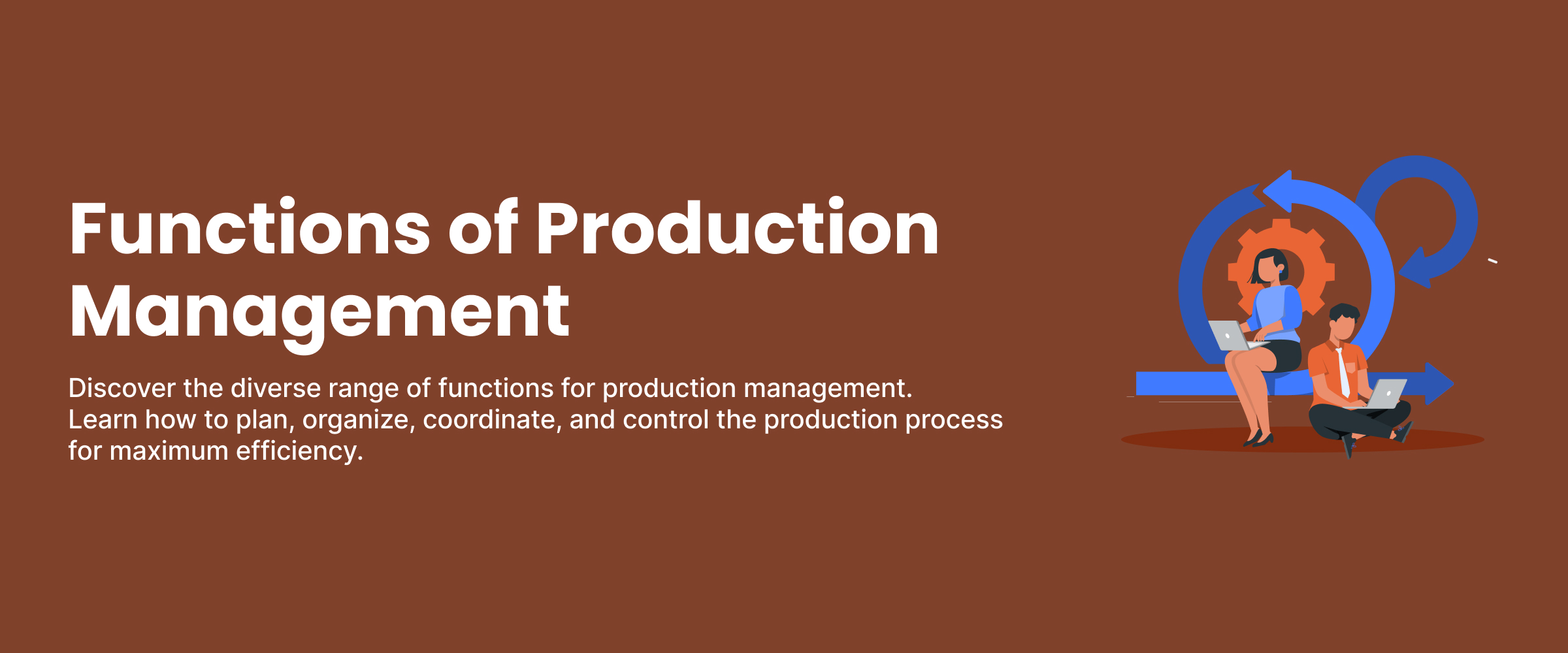Functions of Production Management: The 2025 Guide
Production management is a critical component of any manufacturing or production-oriented organization. It involves planning, organizing, controlling, and optimizing the processes and resources required to produce goods or services efficiently and effectively. With an online product management course candidates can achieve a comprehensive understanding of the subject matter.
In this article, we will explore the key functions of production management and how they contribute to the overall success of an organization.
What is Product Management?
Product management is the systematic process of planning, organizing, controlling, and optimizing the various activities and resources involved in producing goods or services. Its primary objective is to efficiently and effectively transform raw materials, labor, and other inputs into finished products while minimizing costs and maximizing quality.
It plays a pivotal role in the success of manufacturing and production-oriented organizations by enabling them to meet customer demands, control costs, improve product quality, and adapt to changing market conditions.


What are the Functions of Production Management?
Various product management functions are carried out, a few of which are listed below.
| Function | Description | Purpose |
| Production Planning | Involves determining what, how much, and when to produce, ensuring optimal resource utilization, and minimizing production costs. | To forecast demand, set production targets, and create schedules to meet customer requirements while minimizing costs. |
| Process Design and Selection | Identifies the best methods, technologies, and equipment for manufacturing, establishing workflows and procedures for consistent quality. | To design efficient production processes, select appropriate technology, and create SOPs to maintain consistency and quality. |
| Resource Allocation | Assigns materials, labor, machinery, etc., efficiently to meet production targets, minimizing waste and idle time for cost control. | Optimize the allocation of resources, ensuring production goals are met while reducing waste and unnecessary downtime. |
| Quality Control and Assurance | Implements measures for maintaining product quality, setting standards, performing inspections, and executing corrective actions. | To ensure products meet established quality standards, reducing defects and maintaining customer satisfaction. |
| Inventory Management | Manages raw materials, work-in-progress, and completed goods, forecasting demand and optimizing inventory levels to prevent shortages. | To keep adequate stock levels, minimize excess inventory, and prevent production disruptions due to material shortages. |
| Production Scheduling | Generates specific timetables for manufacturing operations, allocating jobs, and managing material flow to meet deadlines and improve resource usage. | To create a detailed production timeline, allocate tasks effectively, and manage material flow for on-time delivery and efficient resource utilization. |
| Cost Estimation and Control | Estimates and monitors production costs for budgeting, employing techniques like cost variance analysis and budget control. | Estimate costs, track expenses, and maintain production operations within the defined budget constraints. |
| Maintenance and Reliability Management | Ensures proper maintenance of machinery, scheduling repairs, and employing strategies to minimize unplanned downtime and enhance equipment reliability. | Schedule and perform regular maintenance, reducing unexpected breakdowns, and ensuring machinery operates reliably for production. |
| Workforce Management | It involves hiring, training, and supervising production staff, defining job roles, setting performance goals, and implementing incentive schemes. | Recruit and train a skilled workforce, define roles, set goals, and create a motivated work environment for improved productivity. |
| Environmental and Safety Compliance | Ensures compliance with environmental and safety regulations, implementing measures to reduce environmental impact and ensure employee safety. | To adhere to environmental standards, minimize environmental impact, and create a safe working environment for employees and the community. |
| Continuous Improvement | Involves ongoing analysis of processes, identifying inefficiencies, and making changes to increase productivity, decrease costs, and improve product quality. | Continuously analyze processes, eliminate inefficiencies, and implement changes for enhanced productivity, reduced costs, and improved product quality. |
| Supplier and Vendor Management | Manages relationships with suppliers and vendors to ensure a steady supply of materials and components, leading to cost savings and enhanced product quality. | Establish and maintain strong supplier relations, ensuring a consistent supply of quality materials while driving cost efficiencies and product quality improvements. |
| Technology Integration | Identifies and implements technology solutions to streamline production processes, enhance data analytics, and improve decision-making, utilizing automation and data analytics. | Integrate technology solutions that improve efficiency, enhance data analysis, and aid in informed decision-making, leveraging automation and analytics in production processes. |


Challenges of Production Management
To adapt to the dynamic nature of modern industrial settings, addressing the difficulties demands a strategic strategy, ongoing process improvement, technology adoption, and an emphasis on agility and adaptability.
Among these difficulties are:
- Demand Variability: Changes in client demand might complicate production planning and scheduling. Order fluctuations can cause overproduction or underproduction, influencing resource usage and inventory management.
- Supply Chain Disruptions: Supply chain disruptions, such as delays in raw material or component delivery, can interrupt production schedules and lead to production bottlenecks.
- Resource Constraints: Limited availability of trained people, gear, or raw materials might limit production capacity, potentially resulting in inefficiencies and increased costs.
- Quality Control: Quality control may be difficult to achieve since flaws and deviations can arise at any manufacturing level, demanding stringent quality control methods.
- Technology Integration: Adapting and integrating new technologies, such as automation and Industry 4.0 concepts, can be costly and difficult, but it is becoming increasingly important to remain competitive.
- Environmental Regulations: Compliance with environmental rules necessitates additional resources and can have an influence on manufacturing operations, particularly in industries with rigorous environmental standards.
- Globalization: Globalization poses logistical and cultural obstacles, such as managing supply chains and conforming to varied legislation.
- Cost Management: Controlling manufacturing expenses, such as labor, materials, and overhead, is a constant problem for maintaining profitability.
- Competitive Pressure: The requirement to remain competitive by providing new goods, shorter lead times, and better customer service places additional strain on production management.
- Volatility in the Market: Rapid changes in market trends and customer preferences can result in inventory obsolescence and higher production risks.
Conclusion
Production management is a multifaceted discipline that plays a vital role in the success of manufacturing and production-oriented organizations. The functions of production management, ranging from planning and resource allocation to quality control and continuous improvement, are interconnected and essential for achieving operational excellence. By effectively managing these functions, organizations can optimize their production processes, reduce costs, improve product quality, and ultimately gain a competitive edge in the market.






